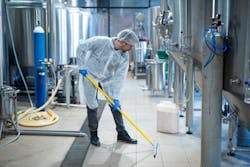The sanitation shift in food & beverage processing plants may be one of the most underappreciated operations, but it is also entirely crucial to producing a safe food supply. Of course, it also may be among the most hazardous to the workers who perform the cleaning, scrubbing and sanitizing tasks required.
“What these people are able to accomplish in a night is really impressive, despite a lot of adversity, and I do think we need to give better credit where credit is due,” says Casey Gallimore, director of regulatory policy for the North American Meat Institute (www.meatinstitute.org), who worked intimately with the sanitation shift at various establishments in her career. “It is not easy to clean a giant plant every night, and they manage to do it.”
She says it can be easy to throw stones for many people because they haven’t worked third shift and don’t see all the challenges the sanitation crews face.
“It’s one thing to ask somebody to work the midnight shift, but [add to that] the chemicals, the environment … it’s like working inside a car wash,” she adds. “But they work so stinking hard, and it’s a thankless job.”
Indeed, most of the news that makes headlines about this thankless shift revolves around an incident or negative situation — beyond that, people tend to be less aware of the challenges faced every day to keep plants clean and their food safe.
To say that the last few years have followed such a script would be an understatement. News of sanitation worker injuries and fatalities did not vanish. Adding fuel to the fire this year, federal investigators began to uncover child-labor law violations across parts of the industry, first with third-party sanitation contractor PSSI and later with individual processing plants, with underage workers on the sanitation crews in many cases.
Of course, one could point to the fact that, even before the Covid-19 pandemic, processors had trouble filling positions on “third shift” over the years. But the post-pandemic labor crisis hasn’t spared processors looking to fill spots on their sanitation crews either, explains Ruth Bitterman, continuous improvement coach for SafetyChain (www.safetychain.com).
“The individuals are generally not well-trained and tend not to have a lot of motivation to continue to come in to complete the job,” she says. “Given the difficulty in finding workers who are trained sanitors and are around long enough to understand the safety issues that exist, safety has continued to be an ongoing challenge.”
Frequent turnover on sanitation, Gallimore says, increases the risk an accident could occur.
“The fact that we struggle to get enough people to run is why we still see safety incidents, because you’ve got employees that you’ve had to put on the floor with training, but maybe not as much training as you’d like to give them,” she explains. “Additionally, you have people who have to help cover responsibilities that are not normally theirs, so they might be unfamiliar or inexperienced with a particular machine or process.”
Sargento Foods (www.sargento.com) focuses its culture on food safety and executes on that through extensive training, says Steve Cahoon, vice president of manufacturing.
“We provide the proper PPE [personal protective equipment] and training to ensure the sanitation teams are prepared and safe,” he says. “The training may take a little longer, but it is important we don’t skip steps and ensure the team members are successful.”
Recruitment and retention of sanitation workers often require unique solutions. Bitterman says some processors are taking extra steps to lure employees to join sanitation and to stick around.
“Some processors are offering incentives to the sanitation workers that had not previously been available to them,” she explains. “[But] finding and retaining qualified sanitation workers has been and continues to be a significant challenge.”
Cahoon says Sargento has found “a good balance with pay, benefits and work-life balance” for its sanitation workers, but clear communication and an emphasis on a food safety culture offer intangible benefits to working for the company's sanitation crews.
“We do our best to make sure teams are responsible, have clear direction and expectations, and know everyone plays a critical role to success,” Cahoon explains. “Ensuring you have a culture that is open and listens, and having an appreciation to other perspectives is key."
Workforce issues aside, the industry is making strides with equipment, chemicals and even some operations and design strategies to help ease the strain on the sanitation crew and the machinery in the plant. Bitterman sees advancements including the use of rapid testing and digital platforms.
“Companies are realizing the power of digital platforms to help track and trend sanitation records as well as provide information on task completion,” she says. “Digital platforms are also being used to house master sanitation schedules and remind workers of tasks to be completed at the scheduled frequencies.”
On the equipment side, Gallimore says, sanitary design continues to rule the roost, and companies are getting better at incorporating lockout-tagout and fail-safe features to ensure employee safety.
“There are also some great tools to help clean some of those pieces of equipment that don’t require a person reaching down into them with their with their hand anymore,” she says. “Automation has been helpful with keeping the plant cleaner during the day, with spray bars on belts that run periodically during the day to help reduce buildup that the sanitation crew has to deal with at the end of the day, for example.”
Manufacturers are designing equipment, and processors designing plants, with sanitation in mind nowadays, Gallimore adds, including taking into account the labor issues, planning for how to clean equipment first, rather than building the machine, handing it off to the processor and letting them worry about how to clean it.
“I don’t think any of that will replace true sanitation, but we've really adopted this multi hurdle approach, with regular sanitation every night and additional sanitation steps taken occasionally to keep overall microbiome down,” she says. “We’re approaching it now as a holistic program versus just trying to beat it down.”
Sargento is one processor that abides by a cooperative strategy with its equipment partners, Cahoon says.
“We work closely with our OEMs and contractors to ensure they are following and delivering set standards that we have implemented ... based on industry best practices, regulatory practices and what we at Sargento deem as best practices,” he says. “We always look at ways to continually improve.”
So long as processors treat sanitation as a crucial part of the equation toward producing high-quality, safe food, Gallimore concludes there’s less risk to the food supply, as well as the workers in the plants.
“The sanitation crew has a stopwatch on it every night when it takes over the plant, and no matter how late production hands it over, they expect operations to start up at the same time, every morning, as clean and sanitized as it was the next day,” she says. “But they’re starting from scratch every night with a whole brand set of surprises every single day, and that's kind of taken for granted when the sanitation crew takes over. It’s a whole different beast every night.”



